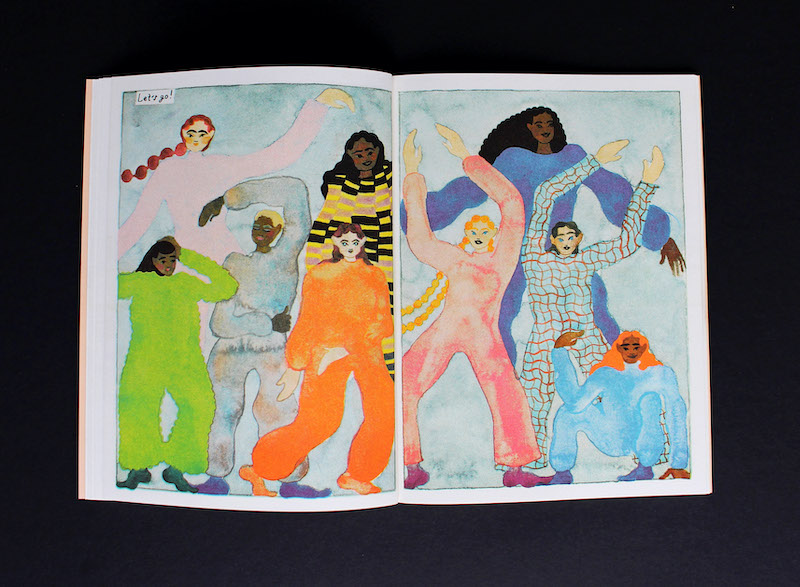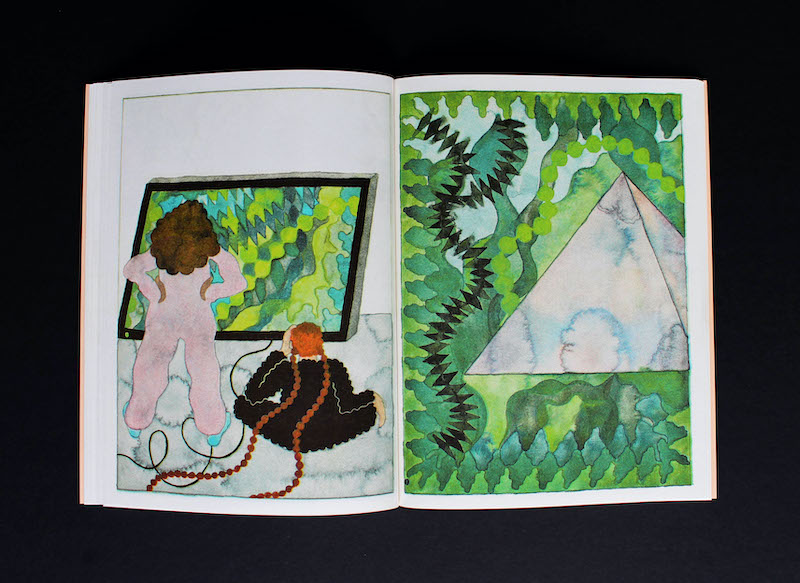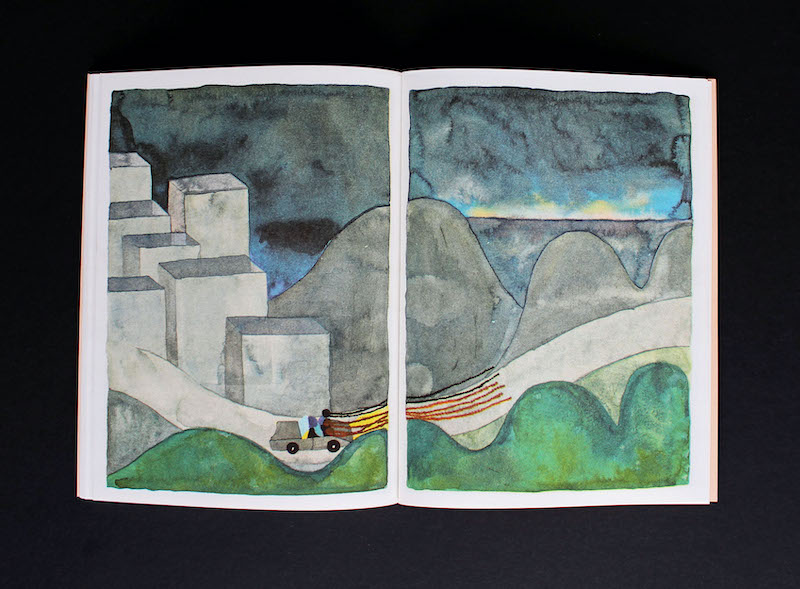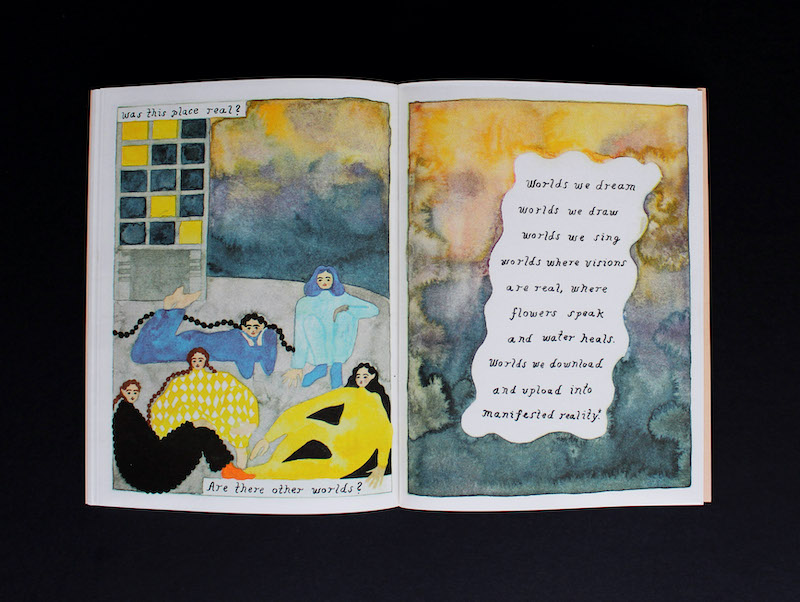by Aoife Donnellan // Feb. 9, 2021
The material experience proffered by Malwine Stauss’ latest publication, ‘The Trip,’ comes at the perfect time. Having not been to a gallery in months, experiencing this enchanting artefact at home provides a similar feeling to witnessing a beloved exhibition in person. Published and printed by Colorama, Stauss’ book is not just a beautiful object, but offers a decidedly tangible experience as well as the potential for connection without leaving your home.
Stauss’ studies began in 2013 at the University of Graphics and Book Art in Leipzig. This is where she developed her practice and founded the collective SQUASH. ‘The Trip’ follows mysterious and tranquil figures traversing pages in pursuit of another place, somewhere they have not been before. The themes within the work encourage a mindful and reflective kind of travel, following a group of femme characters who tumble along through space while experiencing the joys of living. The medium of the work ensures that this peaceful journey can live on your shelf, accessible for you to revisit it in the depths of winter, or lockdown, when you need it most.

Malwine Stauss: ‘The Trip,’ 2020 // Photo by Malwine Stauss, courtesy of the Artist and Colorama
Aoife Donnellan: What inspired you to develop a practice in book arts and illustration? Is there a connection between your other work and your book art practice?
Marwine Stauss: Books and picture books have always been very important and influential to me. As I started my practice, books and series of paintings felt like the most natural way for me to work. I like to develop a story or atmosphere over a series of paintings, and I work in small formats. So, making books always felt like the obvious way to work for me.
I just recently started to try out different media and do new things that I wasn’t used to. It’s very satisfying. At first, I started to paint on a large scale, then I painted on fabric and a few months ago I started to work with clay and make ceramic sculptures. Working with different materials, other than paper and watercolors, is very new to me. I feel like I just started exploring a whole new world and that makes me very happy and gives me a lot of new energy. A lot of people tell me that my sculptural works seem to step out of my paintings, and I find this very interesting, exploring new media to express similar ideas or atmospheres.
AD: Your work takes many different forms, including books, paintings, prints, and silks that could potentially be worn. In what way do you consider the materiality of what you produce?
MS: I work completely intuitively when I choose the color, size and material for my works. I don’t think about what material would fit best for an idea, I just choose what feels most natural and fun to me at the time. I just recently realized that I only ever use natural materials like paper, watercolor, clay, cotton. And I’m completely unable to paint with acrylic paint or use plastic-based material. Although I really love the works other artists create with these materials, I hate the results of my own work when I use them. But that’s not an intentional choice, even though I like the idea that my works are made of natural materials and will one day fall apart and return to the earth.

Malwine Stauss: ‘The Trip,’ 2020 // Photo by Malwine Stauss, courtesy of the Artist and Colorama
AD: Your work features a lot of femme characters who exist in colourful and playful environments. What themes do you explore in your work and what inspired them? How do you think about the bodies that you depict?
MS: The characters and environments in my works are mostly inspired by the aim to create a happy, peaceful and optimistic space. Daily frustrations and my anger and disappointment about social conditions are an important influence for my work. I found a way to translate these feelings and frustrations into something productive and positive with my work.
The first book I made, ‘Hexen,’ that will be published in March 2021 by Rotopol, was my diploma project in 2019 at the Academy of Fine Arts in Leipzig. I made this book in only three months and worked day and night. My frustration about the conditions at the academy was so great [MS1] and constituted the main drive to make the book. I wanted to explore the history of female artists and the reception of women in the history of art—I feel that I stand at the end of that historical line of reception. And I wanted to create a self-conscious and positive work with powerful and hopeful femme protagonists. The femme characters and bodies are so important for my work, as I dislike the role female bodies and characters have had in the past centuries in western art, the role of the muse or the dilettante. I want to show femme characters with the ability to be powerful, self-conscious and creative.
I’m especially interested in the female spiritist painters of the 19th and 20th century and their ideas of magic and intuition. I find the figure of the witch interesting, as she is a clearly powerful, influential and self-determined female character.

Malwine Stauss: ‘The Trip,’ 2020 // Photo by Malwine Stauss, courtesy of the Artist and Colorama
AD: The story of ‘The Trip’ dissolves into a meditative experience represented by shape and colour, how would you categorise the intention of the work?
MS: For ‘The Trip’ I thought about the possibilities of virtual connection in the forming of communities. I thought about the opportunity for virtual connection to create utopian spaces and transfer positive ideas.
I made this book in the winter of 2019/2020 and it feels like a premonition to me now, as the pandemic hit in Germany on the weekend the book was published in March 2020, and virtual connection became more important than ever.
The starting point for the book was my admiration for the conceptual artist Tabita Rezaire. I knew a lot about her work but had never experienced it in reality (and still haven’t to this day). I found it interesting how I could be so positively influenced by an artist whose work I had never experienced outside of the internet. In ‘The Trip’ I wanted to tell a story where reality and virtuality dissolve. The protagonists are going on a trip and it’s unclear if the journey happens in reality or virtually. They experience a positive space they have never experienced before. One of them meets an artist and the artist’s work dissolves into an intuitive space of color and love. When they come back into their own reality, they are changed in a positive way, thinking about other possible worlds.

Malwine Stauss: ‘The Trip,’ 2020 // Photo by Malwine Stauss, courtesy of the Artist and Colorama
AD: What led you to co-found the collective SQUASH and what are the goals of that collective?
MS: I founded the collective SQUASH together with my friends Franz Impler, Lina Ehrentraut and Eva Gräbeldinger during the time at the Academy of Fine Arts Leipzig in 2018. We started to make a magazine together, the SQUASH zine, every issue having a different topic and comics and stories by us. We also started to attend comic festivals and fairs together, doing projects together and supporting each other. I think we were all a bit frustrated with the academy at the time, so it was really good to create our own space to discuss topics and be productive. A big part of our friendship and collaboration is to discuss our works together and to create together. I think we are all influencing each other’s works in different ways, which is very helpful and nice. This year we will organize a comic festival in Leipzig for the first time. The SNAIL EYE festival will take place from May 27th-30th, 2021 in Leipzig.
Artist Info
malwinestauss.com
coloramabooks.space
Exhibition Info
xpinky berlin
Malwine Stauss X Sophie Utikal: ‘worlds we dream’
Exhibition: Feb. 19–Mar. 19, 2021
xpinkyberlin.de
Florian-Geyer-Str. 109a, 12489 Berlin, click here for map





















